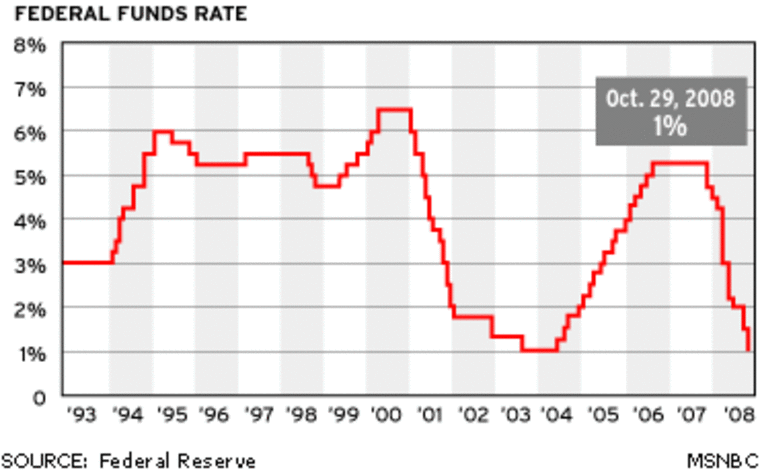The Federal Reserve raised short-term interest rates for the ninth time in a year Thursday, and central bankers gave no indication that they intend to pause anytime soon in their campaign to tighten credit.
Saying the economic expansion "remains firm" despite sharply rising oil prices, Fed Chairman Alan Greenspan and his central bank colleagues raised the overnight lending rate for banks a quarter-percentage point to 3.25 percent, the highest level since shortly after the terrorist attacks of Sept. 11, 2001.
The move will raise costs for a wide variety of business and consumer loans and was followed quickly by a matching quarter-point hike in the prime rate charged by commercial banks, which rose to 6.25 percent.
"Although energy prices have risen further, the expansion remains firm and labor market conditions continue to improve gradually," the Fed said in a statement at the conclusion of a two-day meeting of policy-makers. "Pressures on inflation have stayed elevated, but longer-term inflation expectations remain well contained."
Repeating language the Fed has used repeatedly as it has offered the economy a steady diet of quarter-point rate hikes, central bankers said they expect to be able to continue raising rates at a "measured pace."
"This is a very confident statement," said Mark Zandi, chief economist for Economy.com. "It feels like they are very confident about what they have done so far, and they clearly intend to continue on with their policy."
"The signal from the Fed is that their tightening remains on autopilot," agreed Stuart Hoffman, chief economist at PNC Financial. "It shows a very clear intention to raise rates again," probably by another quarter-point at the upcoming Aug. 9 meeting of policy-makers.
Stock prices dropped sharply as investors quickly concluded the Fed intends to continue raising rates. The Dow Jones industrial average fell about 99 points, or 1 percent, with virtually all the drop coming after the Fed's announcement at 2:15 p.m. ET.
The policy-making Federal Open Market Committee, led by Greenspan, has raised the federal funds rate a quarter-point at every scheduled meeting over the past year, beginning exactly a year ago when the benchmark stood at a 46-year low of 1 percent.
Some analysts believe the Fed is approaching a "neutral" level that would allow the central bank to halt its rate-hiking cycle, or at least take a pause, perhaps after one more quarter-point hike at its next scheduled meeting in August.
But Zandi said he thinks the neutral level is at least 4 percent, meaning the Fed could continue to raise rates into 2006.
Although they did not mention it in the latest statement, Greenspan and other central banking officials have expressed growing concern about steep increases in home prices in many parts of the country, which so far have been unaffected by the Fed's rate-hiking campaign.
In part, that is because of what Greenspan has described as a "conundrum," that even as short-term rates have risen sharply, long-term rates have fallen steadily over the past year, making credit conditions easier for many borrowers, including home buyers. Even after the Fed's move Thursday, long bond rates fell slightly, apparently because bond investors were reassured by the Fed's tough stance on inflation.
To some extent, the booming housing market has offset the negative economic impact of rising oil prices. The nation's economy grew at an impressive 3.8 percent rate in the latest quarter, according to revised figures published this week, exactly the same as the 3.8 percent rate seen in last year's fourth quarter.
Housing contributed 22 percent of the economy's growth in the latest quarter, according to Frank Nothaft, chief economist at mortgage giant Freddie Mac.
Although Greenspan and others at the Fed have expressed some concern about "froth" in the housing market, it is far from clear what they can or should do about red-hot housing prices in many parts of the country. Just this week, rates on 30-year mortgages have fallen to their lowest level in more than a year, according to Freddie Mac.
"Despite this action today, the housing market frenzy will probably only get more frenzied and more frothy in sales and prices over the summer months," Hoffman said. "It doesn't seem there is anything to slow it down."
But Zandi said the booming housing market is one reason why the Fed will continue to raise short-term rates.
Eventually, he said, the Fed will begin to have an impact on the housing market, especially on low one-year "teaser" rates on adjustable mortgages favored in some costly housing markets. that one-year adjustable the increasingly
"The Fed will continue on until it has some measurable impact on housing," Zandi said. If oil prices continue to decline, as they have over the past several days, the Fed may have to be even more aggressive in raising rates to achieve its goal of slowing economic growth to somewhere between 3 and 3.5 percent.
The Fed's latest move brings the federal funds rate to the highest level since Sept. 17, 2001, when the central bank lowered it to 3 percent from 3.5 percent in the aftermath of the 9/11 attacks. The Fed brought the rate down rapidly over the next three months amid fears of a potentially deep recession.
In fact a relatively mild eight-month recession had ended in November 2001, although that would not become clear until many months later. Meanwhile the Fed continued to push short-term rates down through mid-2003 in an effort to spur job creation in an anemic economic recovery.
